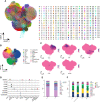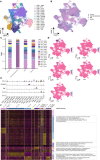A Landscape Study on COVID-19 Immunity at the Single-Cell Level
- PMID: 35911765
- PMCID: PMC9334848
- DOI: 10.3389/fimmu.2022.918383
A Landscape Study on COVID-19 Immunity at the Single-Cell Level
Abstract
Since 2019, the coronavirus (COVID-19) has outbroken continuously, spreading internationally and threatening the public health. However, it was unknown how the disorder at the single-cell level was associated with the pathogenesis of COVID-19. This study presented the disorders of macrophages, epithelial cells, CD8+ T cells, and natural killer (NK) cells at the single-cell level in the courses of COVID-19 and analyzed the immune response to cytokine storm. Compared with the healthy group, patients with COVID-19 had higher proportions of macrophages and lower proportions of T and NK cells, especially proportions of macrophages and epithelial cells with an increase during patients' conditions from mild to severe. This study suggested that there were high levels of pro-inflammatory and chemokine expressions in cells of COVID-19 and analyzed cell subsets to explore its changes and pathways. It was worth noting that several subsets of macrophages, epithelial cells, CD8 T cells, and NK cells were involved in inflammation pathways, including interleukin-17 (IL-17) signaling pathway and tumor necrosis factor (TNF) signaling pathway. Moreover, the pathways interacting COVID-19 and cytokine receptor with each other were remarkably enriched. In addition, these cell subsets played important roles in inflammation, and their abnormal functions may cause COVID-19. In conclusion, this study provided an immune outlook for COVID-19 at the single-cell level and revealed different pathways in immune response of COVID-19 single cells.
Keywords: COVID-19; cytokines; immunity; signaling pathway; single-cell.
Copyright © 2022 Wei, Qin, Huang, Liu, Cheng, Meng and Wang.
Conflict of interest statement
The authors declare that the research was conducted in the absence of any commercial or financial relationships that could be construed as a potential conflict of interest.
Figures





Similar articles
-
Clinical Characteristics and Immune Injury Mechanisms in 71 Patients with COVID-19.mSphere. 2020 Jul 15;5(4):e00362-20. doi: 10.1128/mSphere.00362-20. mSphere. 2020. PMID: 32669467 Free PMC article.
-
Mast cells activated by SARS-CoV-2 release histamine which increases IL-1 levels causing cytokine storm and inflammatory reaction in COVID-19.J Biol Regul Homeost Agents. 2020 Sep-Oct,;34(5):1629-1632. doi: 10.23812/20-2EDIT. J Biol Regul Homeost Agents. 2020. PMID: 32945158
-
Coronavirus-19 (SARS-CoV-2) induces acute severe lung inflammation via IL-1 causing cytokine storm in COVID-19: a promising inhibitory strategy.J Biol Regul Homeost Agents. 2020 Nov-Dec;34(6):1971-1975. doi: 10.23812/20-1-E. J Biol Regul Homeost Agents. 2020. PMID: 33016027
-
Deciphering the COVID-19 cytokine storm: Systematic review and meta-analysis.Eur J Clin Invest. 2021 Jan;51(1):e13429. doi: 10.1111/eci.13429. Epub 2020 Nov 2. Eur J Clin Invest. 2021. PMID: 33058143 Free PMC article.
-
Disruption of CCR5 signaling to treat COVID-19-associated cytokine storm: Case series of four critically ill patients treated with leronlimab.J Transl Autoimmun. 2021;4:100083. doi: 10.1016/j.jtauto.2021.100083. Epub 2021 Jan 6. J Transl Autoimmun. 2021. PMID: 33521616 Free PMC article. Review.
Cited by
-
SARS-CoV-2-specific T cell therapy for severe COVID-19: a randomized phase 1/2 trial.Nat Med. 2023 Aug;29(8):2019-2029. doi: 10.1038/s41591-023-02480-8. Epub 2023 Jul 17. Nat Med. 2023. PMID: 37460756 Clinical Trial.
References
Publication types
MeSH terms
LinkOut - more resources
Full Text Sources
Medical
Research Materials

